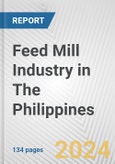The first two chapters of the report feature the country profile by giving general information on Philippines and by thoroughly studying its economic state (including key macroeconomic indicators and their development trends).
The third chapter covers common business procedures in the country: from starting a project to closing a business. This chapter elucidates the country’s fiscal system, existing labour practices, property rights regulation peculiarities and other issues vital for running business in this country.
Further the report analyses feed mill industry in the country. This key chapter tells about main trends in the industry, identifies key market players (including major producers, traders, etc.), and evaluates trade operations within the sector in the recent years.
Related news bulletins update adds the finishing touch to an overview of economic situation in Philippines.
This product will be delivered within 3-5 business days.
Table of Contents
1. Philippines: Country Profile1.1. Geographical Position
1.2. Historical Background
1.3. Demography
1.4. Administrative Divisions
1.5. Political Situation
1.6. Economic Situation
1.7. Foreign Relations
1.8. Social Environment and Culture - Cultural Differences and Their Impact on Business Negotiations
2. Philippines: Financial and Economical Profile
2.1. Country's Gross Domestic Product (GDP): Historical Trends and Projection
2.3. Industrial Production Outlook
2.4. Philippines Foreign Trade
2.2. Current Investment Climate
2.5. Labor Market Overview - Current Employment State
2.6. Ratings by Major Rating Agencies
3. Peculiarities of Doing Business in Philippines
3.1. Procedures for Starting a Business
3.2. Routine for Building Permits Obtaining
3.3. Registration of Ownership Rights
3.4. Basic Terms of Providing Business Loans by Banks
3.5. Measures for Investments Protection
3.6. Tax System
3.7. Foreign Trade Transactions
3.8. Debt Collection
3.9. Business Liquidation
4. Philippines Feed Mill Industry Overview
4.1. Overview of Feed Mill Industry in Philippines: Current State and Trends
4.2. Major Players on the Feed Mill Market in Philippines
4.3. Philippines Foreign Trade in Animal Feed: Volume, Structure, Dynamics
4.3.1. Export and Import of Meals of Fish, Including Fish Flour and Prepared Fish Meals: Volume, Structure, Dynamics
4.3.2. Export and Import of Corn, Wheat, Rice and Beans Bran: Volume, Structure, Dynamics
4.3.3. Export and Import of Swedes, Mangolds, Fodder Roots, Hay and Similar Forage Products: Volume, Structure, Dynamics
4.3.4. Export and Import of Oil-Cake and Other Solid Residues, Whether or Not Ground or in the Form of Pellets, Resulting from the Extraction of Soyabean Oil: Volume, Structure, Dynamics
4.4. Foreign Trade in Machinery for Preparing Animal Feeding Stuffs
5. Philippines Economy News and Analysis Digest








